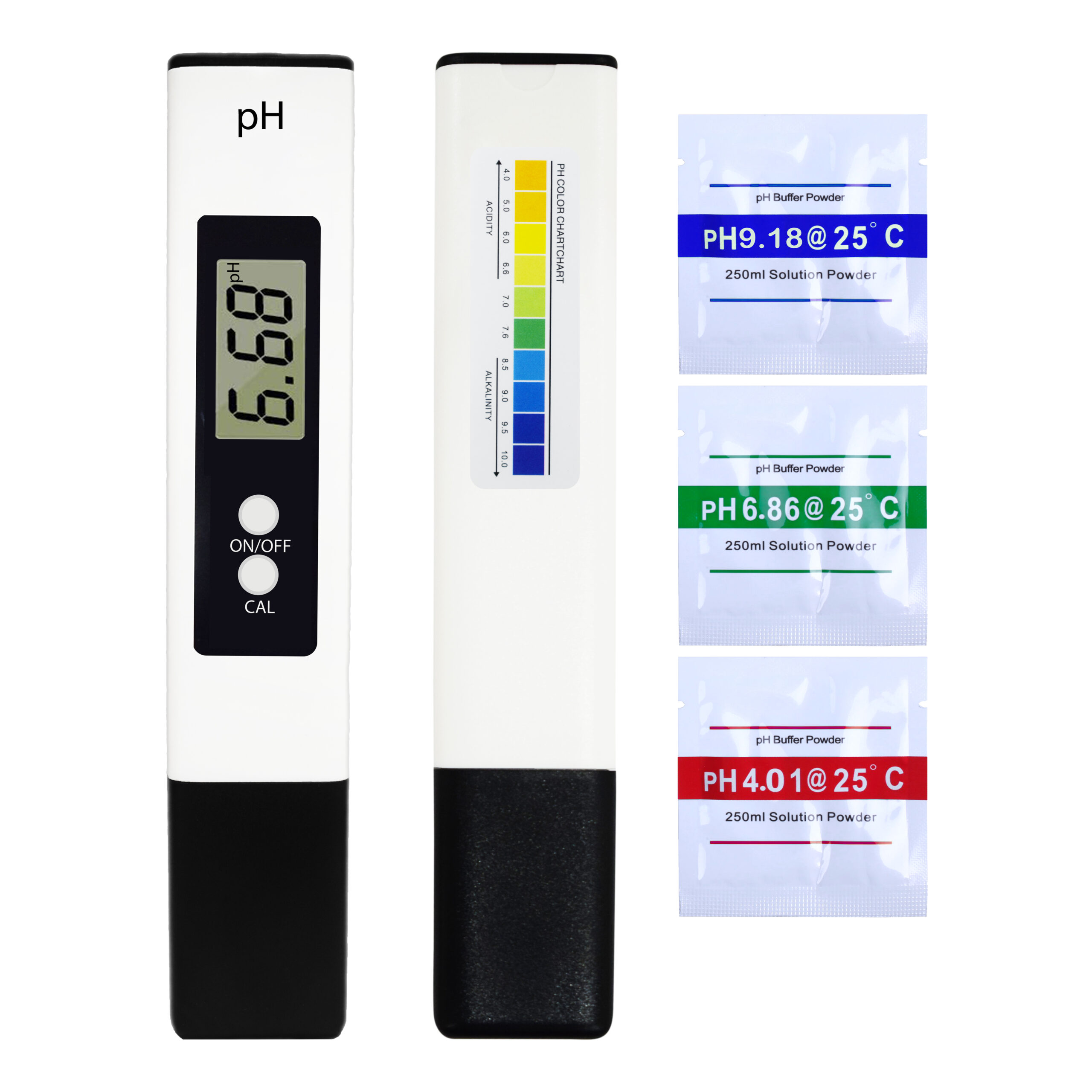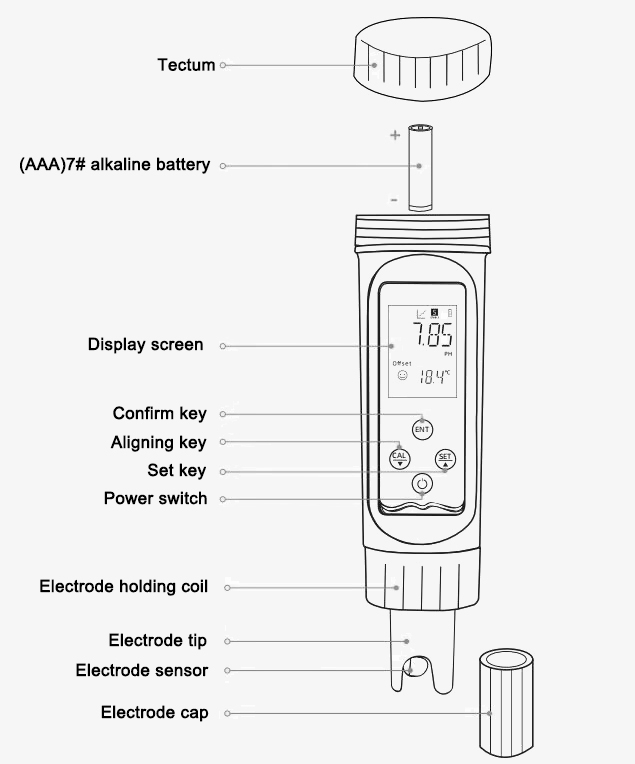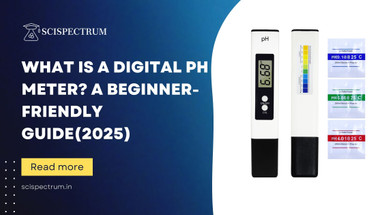Posted by Scispectrum on 8th Sep 2025
What Is a Digital pH Meter? A Beginner-Friendly Guide (2025)
Why pH Measurement Matters
From safe drinking water and aquariums to gardening, food safety, cosmetics, and laboratory research, measuring pH (acidity/alkalinity) is essential. A digital pH meter makes this easy by showing an accurate number on a screen no guesswork from color strips.
This guide explains digital pH meters in simple terms, how they work, where they’re used, and how to choose and care for one. Real product examples are included from the provided catalog to help you match features to your needs.
Digital pH Meter: Simple Definition

A digital pH meter is an electronic instrument that measures how acidic or alkaline a solution is on the pH scale (0 to 14):
0–6.9: acidic (e.g., vinegar, lemon juice)
7.0: neutral (pure water)
7.1–14: alkaline/basic (e.g., baking soda solution)
The meter uses a probe (electrode) to detect hydrogen ion activity and converts it into a pH value displayed on a screen—usually within seconds.
Why digital wins over paper strips:
Higher accuracy (as fine as 0.01 or even 0.001 pH)
Faster, repeatable readings
Extra features like ATC (Automatic Temperature Compensation), memory, and PC connectivity
How Does a Digital pH Meter Work?
Inside the probe is a special glass membrane that senses hydrogen ions (H+). When dipped in a sample:
Hydrogen ions create a tiny voltage at the glass surface.
The meter’s electronics (microprocessor) translate that voltage into a pH number.
With ATC, the meter auto-corrects for temperature, since pH readings shift with heat/cold.
The final pH appears on the screen—typically in 2–10 seconds.
Key components:

Glass pH electrode (often refillable or sealed)
Reference electrode (stable baseline)
Temperature sensor (for ATC)
Meter/display (handheld or benchtop)
Where Are Digital pH Meters Used?
Water quality: drinking water, RO units, pools, aquariums, hydroponics
Gardening and soil: soil slurries, nutrient solutions
Food and beverage: brewing, dairy, fermentation (yogurt, kombucha)
Cosmetics and personal care: lotions, shampoos, skincare formulations
Laboratories and industry: research, pharmaceuticals, chemical processing
Education: classrooms and training labs
check out this beginner’s guide to pH meters.
Examples from the catalog:
Home/field checks: LUTRON PH 201 PH METER (Portable), PH METER PH602 PLUSK (Portable)
Food/semi-solids: PEN TYPE Model PH SPEAR (spear-tipped for gels, slurries)
Labs/QA/QC: EUTECH PH ECPH270042GS (0.001 pH), AQUASOL BENCH TOP ABPH01 (USB + stirrer)
Types of Digital pH Meters (With Use-Case Fit)
Portable meters (field-ready)
Battery-powered; great for quick checks in aquariums, farms, and pools.
Examples:
PH WP61042K / WP60042K (pH, mV, 500-memory, RS-232)
PH WP 450 02K (pH, Ion, mV; memory + RS-232)
PH WP 150 02K (budget; 150-memory, no output)
PH METER PH602 PLUSK (no memory/output; basic)
Pen-type testers (pocket-size)
Compact, beginner-friendly, ideal for home users and students.
Examples:
PH TEST 30 (0.01 pH, ATC, temperature display)
PH TEST 20 (0.01 pH, ATC, big display)
PH TEST 10 (0.1 pH, ATC; budget)
PH TEST 10 BNC (0.01 pH; BNC interface; electrode sold separately)
ECO PH TEST 1 / ECO PH TEST 2 (0.1 pH, auto-cal; beginner)
PEN TYPE Model PH SPEAR (0.01 pH; spear tip for semi-solids)
PH EXPERT EUTECH (3-point calibration; general pocket use)
Benchtop meters (lab-grade)
High precision, stable stands, data logging, multi-point calibration.
Examples:
EUTECH PH ECPH70042S (0.01 pH; 5-point; accessories included)
EUTECH PH ECPH270042GS / ECPH27005E (0.001 pH; 6-point; RS-232)
HANNA HI2211 02 (pH & mV; reliable bench unit)
HANNA HI2020 02 (multiparameter; 230V)
METTLER TOLEDO FP20 BIO KIT (0.01 pH; LE410 sensor; food/bio labs)
AQUASOL ABTPH (general lab use)
AQUASOL ABPH01 (USB software + built-in stirrer)
MICROPROCESSOR PH METER 1015 (±0.002 pH; 5-point; memory 999)
MICROPROCESSOR PH ION METER 1016); ESICO 1016; BR BIOCHEM PH METER); Sky series
Electrodes and online monitoring
LUTRON PH 208) kit (with PE03 electrode + TP07 temp probe)
EUTECH GENERAL PURPOSE ELECTRODE) (ECFC7252101B)
DIGITAL ONLINE PH INDICATOR (for continuous monitoring)
Note: The catalog also lists conductivity meters (HM COM80, AQUASOL AMCOND01/AMCOND02, HANNA 98304). These measure EC/TDS, not pH useful companions for water analysis.
Key Features To Look For (Beginner Buyer’s Guide)
Accuracy and resolution
Entry-level: ±0.1 pH (e.g., PH TEST 10), ECO PH TEST 1)
General lab/serious hobby: ±0.01 pH (e.g., PH TEST 30, EUTECH 700 series)
High-precision research: 0.001 pH (e.g., EUTECH 2700 series)
ATC (Automatic Temperature Compensation)
Essential when samples are not at room temperature.
Calibration
2–6 points; more points improve accuracy across the pH range.
Memory and data output
RS-232/USB for logging and audit trails (e.g., WP61042K, ECPH2700, ABPH01).
Probe type and replaceability
General-purpose vs spear/flat tips; replaceable electrodes reduce long-term cost.
Build and ergonomics
Portable for fieldwork; benchtop with arm/stand for lab stability.
Range
Typical: -2 to 16 or 0 to 14 pH (check your application requirements).
Quick matches:
Simple home checks: Lutron PH-201, PH METER PH602 PLUSK, ECO PH TEST 1
Semi-solids/food: PH SPEAR
Data logging in field: PH WP61042K / WP60042K
Labs needing 0.001 pH: EUTECH ECPH270042GS / ECPH27005E
Labs needing stirring + USB: AQUASOL ABPH01
How To Use a Digital pH Meter (Step-by-Step)
Calibrate the meter with fresh buffers (pH 7.0, 4.0, and/or 10.0).
Rinse the probe with distilled water; gently blot dry (no rubbing).
Immerse the probe in your sample; stir gently or use a magnetic stirrer (benchtop).
Wait for the reading to stabilize; note the temperature if shown.
Rinse and store the probe correctly after use.
Pro tips:
For soil: mix 1 part soil with 2 parts distilled water; let settle; measure the liquid phase.
For carbonated samples: degas first (stir gently to release CO₂).
Maintenance: Keep Your Meter Accurate
Always store the pH electrode in storage solution (usually KCl). Never store dry.
Rinse with distilled water after measurements.
Calibrate monthly or before critical tests.
Replace electrodes every 12–24 months or when readings drift/slow down.
Keep buffer solutions capped, clean, and within expiry.
For sticky/greasy samples (food/cosmetics), clean the bulb with a suitable electrode cleaner.
Common Mistakes to Avoid
Using tap water for rinsing (minerals can contaminate the bulb)
Storing the probe dry or in pure water (damages the reference)
Using expired/contaminated buffers for calibration
Ignoring temperature effects (use ATC or measure near room temperature)
Forcing the probe into semi-solids (use a spear-tip like PH SPEAR)
Quick Product Examples (From the Catalog)
Beginner-friendly portable:
Lutron PH-201 PH Meter (LUTRON PH 201 PH METER)
PH METER pH602 PLUSK (PH METER PH602 PLUSK) (basic pH/mV; no memory/output)
Portable with memory/PC output:
pH WP61042K (PH WP61042K) / pH WP60042K (PH WP60042K) (pH, mV; 500-memory; RS-232)
pH WP 450 02K (PH WP 450 02K) (adds Ion and mV)
Pen-type for accuracy and ease:
PH TEST 30 / PH TEST 20 (0.01 pH; ATC)
PH TEST 10 (0.1 pH; ATC; budget)
ECO PH TEST 1 / 2 (auto-cal; beginner)
PH SPEAR (PH SPEAR) (semi-solids)
Benchtop for labs:
EUTECH PH ECPH70042S (0.01 pH; 5-point)
EUTECH PH ECPH270042GS / 27005E (0.001 pH; 6-point; RS-232)
HANNA HI2211 02; HANNA HI2020 02
AQUASOL ABTPH / ABPH01 (ABPH01 adds stirrer + USB)
MICROPROCESSOR PH METER 1015 (±0.002 pH; memory 999)
Electrodes and online:
Eutech ECFC7252101B (general-purpose electrode)
LUTRON PH 208 with PE03 electrode + TP07 temp probe
DIGITAL ONLINE PH INDICATOR (continuous monitoring)
FAQs: Digital pH Meters
Q1) What is a digital pH meter used for?
Testing acidity/alkalinity in water, soil, food, cosmetics, and lab samples. It offers fast and accurate readings on a numeric display.
Q2) Do I need ATC?
Yes, if your sample isn’t at room temperature. ATC improves accuracy by compensating for temperature changes.
Q3) How often should I calibrate?
Monthly for routine use; more often for critical measurements or after probe replacement.
Q4) Can one meter test both water and semi-solids?
Yes, if it supports compatible electrodes. For semi-solids, use a spear-tip like the PH SPEAR (PH SPEAR).
Q5) What accuracy is “good enough”?
Home/aquarium: ±0.1 to ±0.02 pH
Brewing/serious hobby: ±0.01 pH
Labs/QA/QC: 0.001–0.002 pH
Q6) Why is my reading unstable?
Causes include: dirty/dry probe, old buffers, temperature fluctuation, or a failing electrode. Clean, rehydrate, and recalibrate.
Q7) Are conductivity pens the same as pH meters?
No. Conductivity/TDS pens (e.g., HM COM80, AQUASOL AMCOND01/02, HANNA 98304) measure dissolved ions, not pH. They complement pH testing.
Conclusion: Choose the Right Meter for Your Needs
Beginners and home users: start with a pen-type or simple portable (ECO PH TEST 1, PH TEST 10, Lutron PH-201, pH602 PLUSK).
Field users and pros who log data: pick models with memory and RS-232 PH WP61042K, PH WP60042K, PH WP 450 02K).
Laboratories and QA/QC: aim for high precision and connectivity (EUTECH ECPH2700 series, AQUASOL ABPH01), MICROPROCESSOR PH METER 1015).
Food and semi-solids: use a spear-tip electrode (PH SPEAR) or lab systems like METTLER TOLEDO FP20 BIO KIT.
With the right meter, proper calibration, and good storage habits, digital pH measurement becomes simple, reliable, and cost-effective.

